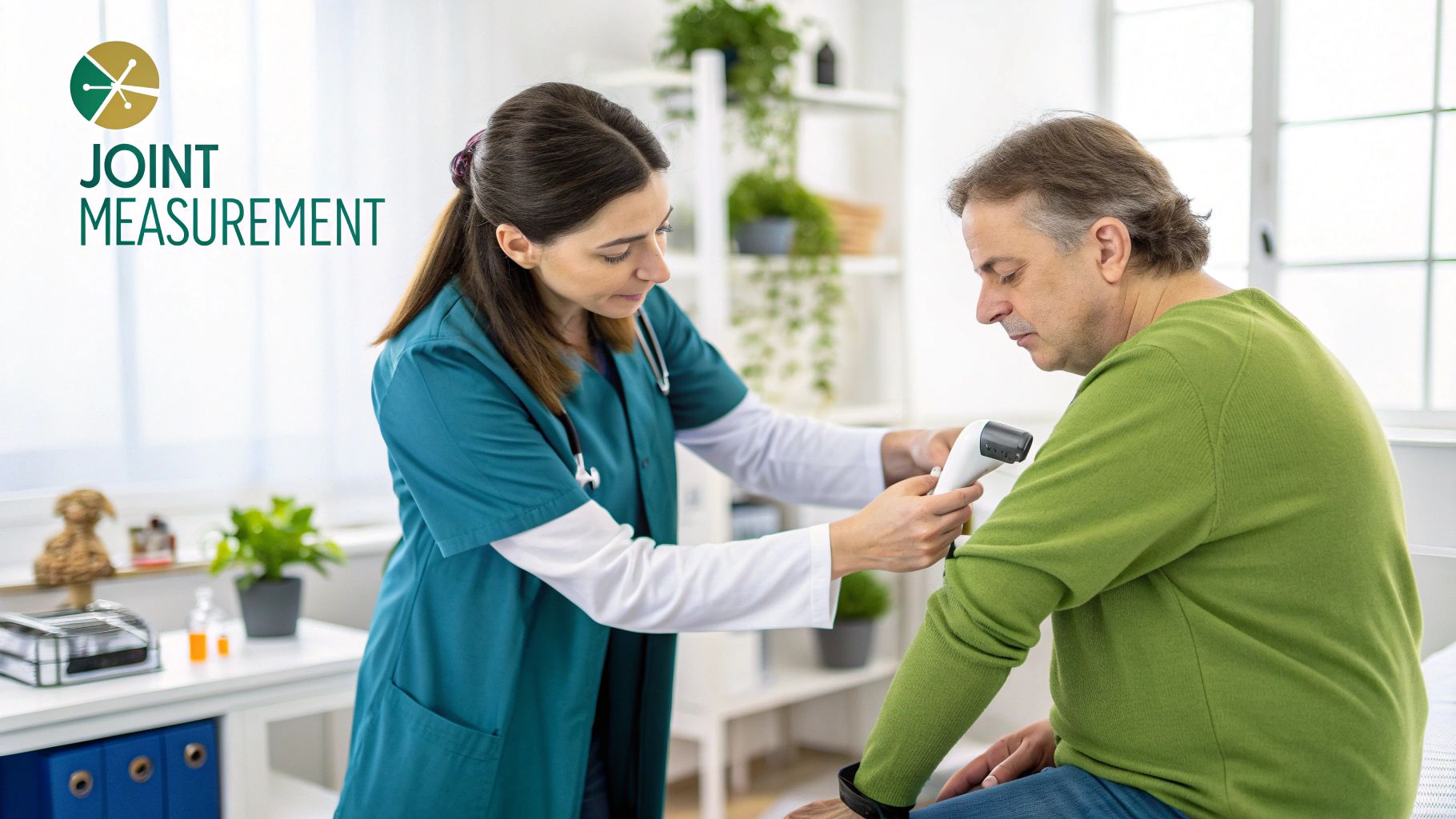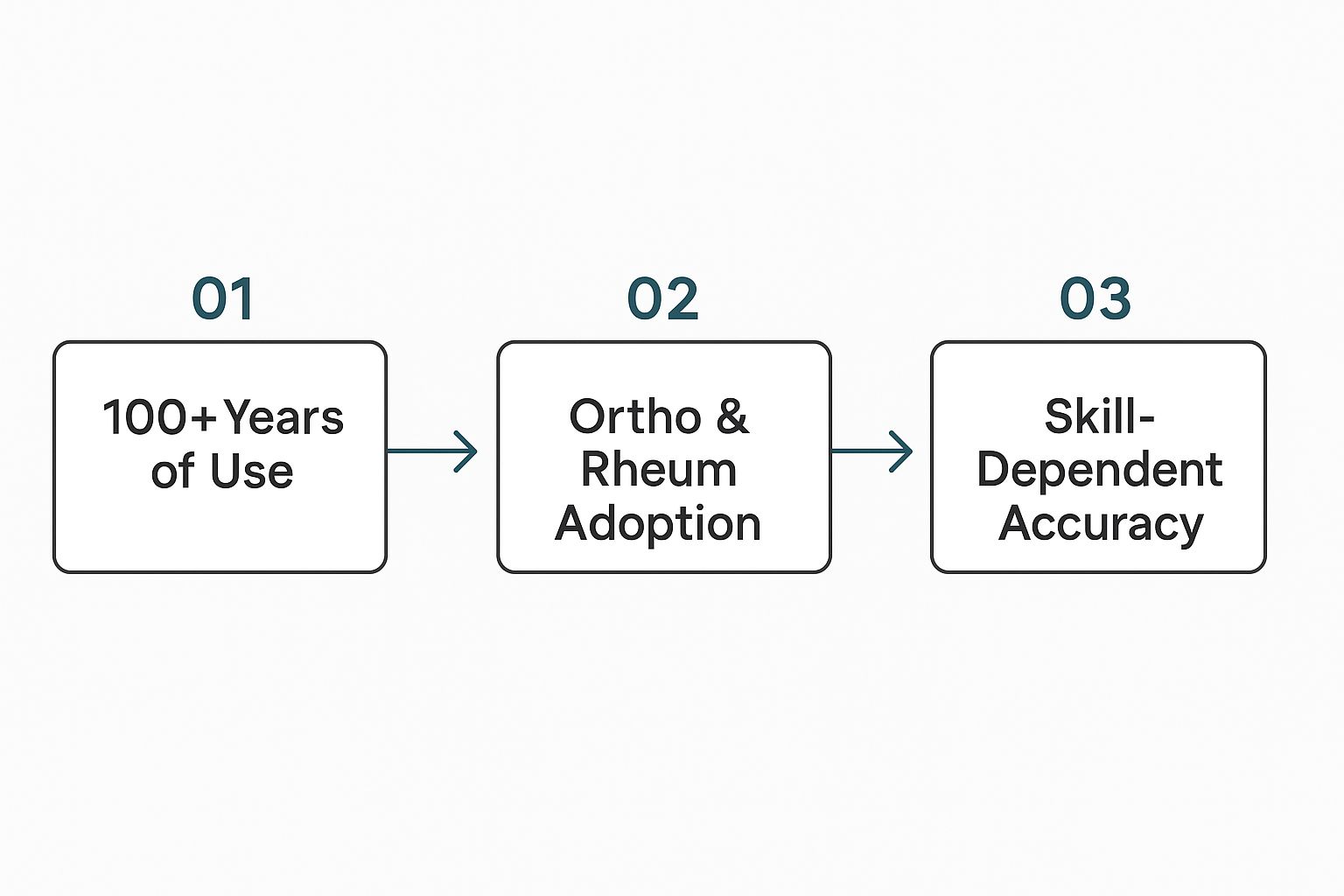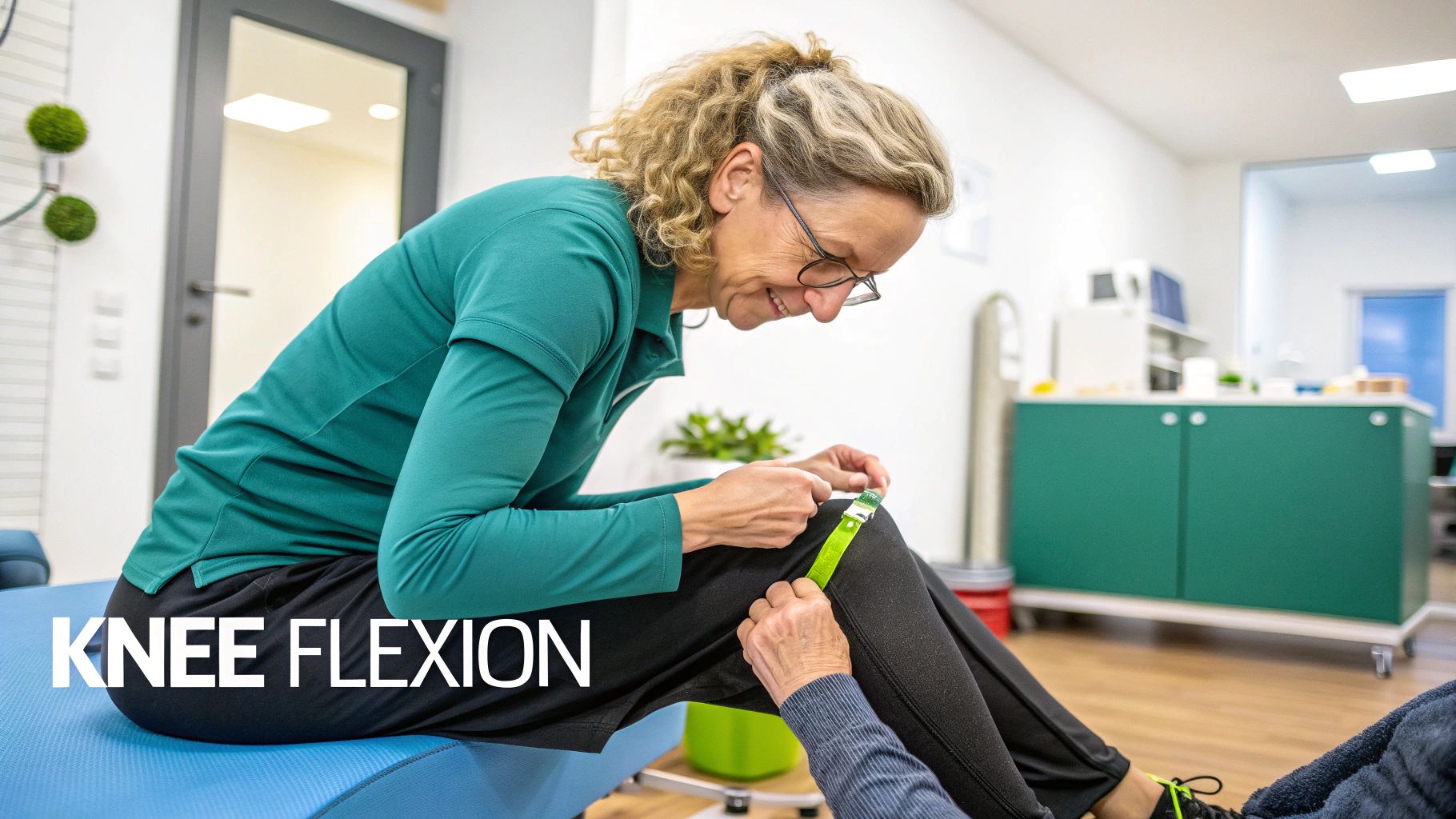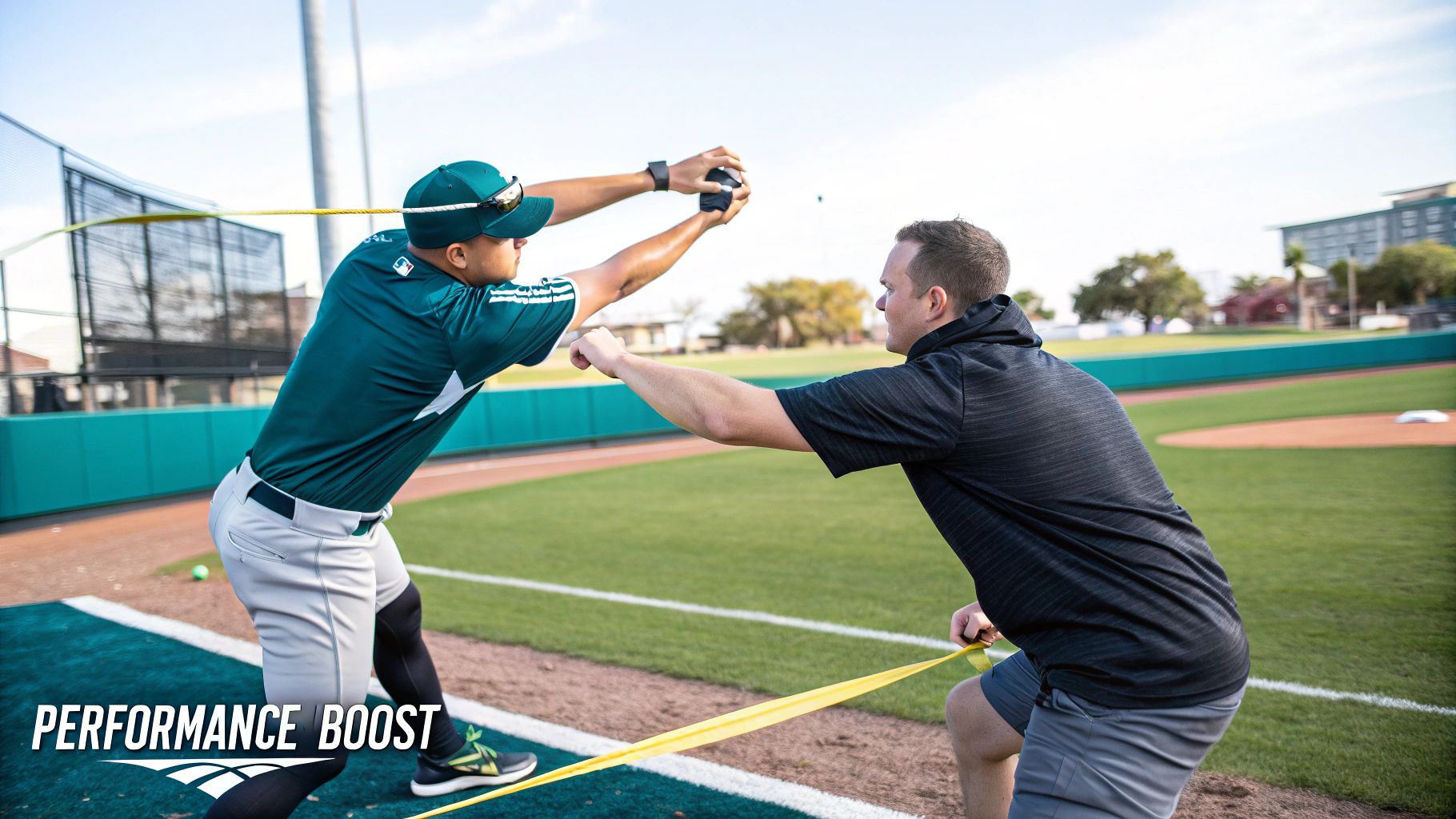-

, by Marko Dombi Athlete-Centric Care: Elevating ACL Rehab with Next-Gen Performance Tools
-

, by Marko Dombi Launch of the EasyBase - Force Plate System For Rehabilitation and Sports
-

, by Marko Dombi Interview with the researcher | Enhanced Paper Grip Test Project
What Is a Goniometer Used For? An Essential Tool in Sports & Rehab
- , by Team Meloq
- 13 min reading time

Wondering what is a goniometer used for? Learn how this key device measures joint angles to aid recovery, improve mobility, and boost performance.
Ever wonder how a physical therapist knows exactly how far your knee can bend after an injury or how much your shoulder mobility has improved? They're not just guessing. They're using a goniometer to get precise measurements of a joint's range of motion.
Think of it as a protractor designed specifically for the human body. It allows clinicians and sports medicine professionals to ditch the guesswork and rely on objective, reliable data for everything from injury assessments to tracking rehabilitation progress.
Measuring What Matters in Movement

At its heart, a goniometer provides a numerical value for joint flexibility. It’s a simple concept, but it's foundational to physiotherapy, rehabilitation, and conditioning.
Instead of just saying a joint is "stiff," a therapist can record a specific angle, like 95 degrees of knee flexion. This shift from subjective feeling to concrete data is the bedrock of evidence-based practice.
This ability to capture real numbers lets clinicians set a clear baseline after an injury or surgery. From there, they can establish measurable recovery goals and track progress week by week. Seeing a patient’s range of motion climb from 95 to 120 degrees is undeniable proof that the treatment plan is working (1).
Key Applications of Goniometry
The goniometer is a versatile tool, touching nearly every aspect of musculoskeletal health. Here are a few key areas where these measurements make a massive difference:
- Post-Injury and Post-Surgical Rehab: After a fracture, ligament tear, or joint replacement, a goniometer is essential for monitoring the return of normal movement and ensuring the recovery stays on track.
- Diagnosing Movement Limitations: It helps pinpoint the exact degree of limitation in conditions like frozen shoulder or arthritis, providing crucial information for an accurate diagnosis.
- Athletic Performance and Conditioning: In sports, optimal joint angles are directly linked to peak performance and injury prevention. For instance, measuring a pitcher's shoulder rotation can help fine-tune their mechanics for more power and less strain. This data also plays into an athlete's power output, a concept you can dive into by learning about the rate of force development.
To put it simply, here’s a quick overview of where this tool shines.
Goniometer Applications at a Glance
| Application Area | Primary Use | Who Benefits |
|---|---|---|
| Clinical Rehabilitation | Tracking recovery progress after surgery or injury. | Physical therapists, occupational therapists, patients. |
| Diagnostics | Quantifying joint limitations for conditions like arthritis. | Orthopedists, rheumatologists, primary care physicians. |
| Sports Performance | Optimizing biomechanics and preventing injuries. | Athletic trainers, strength coaches, athletes. |
| Ergonomics | Assessing workplace setups to reduce strain. | Ergonomists, occupational health specialists, employees. |
This table just scratches the surface, but it highlights how a simple measurement tool can have a wide-ranging impact across different fields.
A goniometer transforms a subjective observation into an objective measurement. This shift is essential for creating effective treatment plans, documenting patient progress for insurance purposes, and empowering individuals with tangible evidence of their recovery journey.
Ultimately, by providing a standardized and reliable way to assess joint function, the goniometer remains a cornerstone of modern physical therapy and sports medicine.
A Century of Measurement in Clinical Practice
For over 100 years, the goniometer has been a trusted tool in any clinic focused on musculoskeletal health (2). Think of it as the original piece of objective technology, designed to put hard numbers to what used to be a subjective guess about joint movement. It became a go-to instrument in demanding fields like orthopedics and rheumatology.
In today's practice, you'll see it used for all sorts of assessments. A therapist might grab one to measure the precise degrees of spinal mobility in a patient with ankylosing spondylitis, a condition known for causing spinal fusion. Or, after an athlete has surgery on a fractured elbow, the goniometer provides the clear, unambiguous data needed to track their extension and build a solid rehabilitation plan.
This flowchart neatly sums up the goniometer's long-standing adoption and the one non-negotiable principle for its use today.

As the graphic shows, while the tool itself is simple and has been trusted for generations, its real power lies in the hands of the clinician using it.
The Importance of Proper Technique
A goniometer is sensitive enough to pick up even tiny shifts in joint flexibility, but its accuracy is only as good as the clinician's technique. A skilled hand is everything. Inconsistent placement or a slight wobble can throw off the readings, which could misdirect a patient's treatment plan. Good training ensures every measurement is both valid and repeatable—the two things that matter most for tracking progress (1).
A major risk with improper use is causing an iatrogenic injury—that is, an injury caused by the medical examination itself. Forcing a joint past its comfortable range, especially in a patient with fragile bones from a condition like osteoporosis, can do real harm.
This is why understanding what a goniometer is used for goes far beyond just taking a measurement; it’s about conducting a safe and effective assessment. The value of proper training cannot be overstated. It’s what keeps this century-old tool an essential part of modern physical medicine. You can dive deeper into its applications by exploring this in-depth analysis of goniometry.
How Professionals Measure Joint Motion
Getting an accurate read on a joint's range of motion is more nuanced than simply placing a goniometer on an arm or leg. A standardized process is followed for good reason: to obtain reliable, repeatable numbers that can serve as a solid baseline for any treatment plan.
Let’s walk through how a professional would do it, using the classic example of measuring knee flexion.
First things first: patient positioning is crucial. For a knee flexion test, the patient usually lies on their back. This simple step helps stabilize the hip and isolate the knee joint, making sure the measurement reflects only the knee’s movement and not compensation from other parts of the body (1).

Once the patient is set, the therapist will find a few key anatomical landmarks. Think of these bony points as consistent signposts that guide exactly where the goniometer goes, every single time.
Aligning the Goniometer for an Accurate Reading
The goniometer itself has three key parts, and each one needs to be lined up perfectly with these landmarks for the reading to be trustworthy:
- Fulcrum: This is the pin right in the center of the protractor. It goes directly over the joint’s axis of rotation—in this case, the lateral epicondyle of the femur on the side of the knee.
- Stationary Arm: This arm doesn't move. It’s aligned with the thigh, pointing toward a landmark on the hip (the greater trochanter).
- Moving Arm: As the patient bends their knee, this arm follows the motion. It’s lined up with the lower leg (specifically the fibula), pointing toward the bony bump on the outside of the ankle (the lateral malleolus).
As the patient moves, the therapist holds the fulcrum and stationary arm steady while the moving arm tracks the motion. The final angle on the goniometer is the precise measurement of knee flexion. This isn't just an observation; it's objective data that is absolutely essential for tracking progress. The same principles of objective measurement are critical in more advanced assessments, such as those discussed in our guide to force plate testing.
Consistency is the cornerstone of reliable goniometry. Using the same patient position, anatomical landmarks, and even the same therapist for follow-up measurements helps eliminate variables and ensures that any change in the readings reflects a true change in the patient’s joint function.
Boosting Athletic Performance and Preventing Injury
In the world of sports, a goniometer is so much more than a post-injury recovery tool—it's a critical instrument for getting ahead of the game. Sports therapists and strength coaches lean on range of motion (ROM) data to find a competitive edge, turning simple measurements into real athletic gains.
By precisely measuring joint angles, they can spot subtle biomechanical imbalances that might otherwise go completely unnoticed until an injury sidelines an athlete. These asymmetries or limitations can point directly to an athlete's "weak link," giving clinicians a clear roadmap for what to work on.

From Measurement to Peak Performance
Identifying these limitations is the first step. The real magic happens when this data is applied to an athlete's training program, unlocking their full potential and building resilience against injury.
- Optimizing Mechanics: Think about a baseball pitcher. Assessing their shoulder's external rotation can help fine-tune throwing mechanics for maximum velocity while minimizing stress on the joint. Insufficient ROM here could force compensations that lead to injury.
- Improving Power Output: For sprinters or jumpers, optimal hip and ankle flexibility is directly tied to how much power they can generate. Measuring these angles helps coaches design mobility routines that actually work. You can see how this translates to performance by looking into the average jump height and what it means for athletes.
- Preventing Common Strains: In endurance runners, limited hip extension often leads to nagging hamstring or lower back issues. Goniometry provides the hard data needed to address this before it becomes a chronic problem.
Goniometry provides the objective data needed to move beyond generic training templates. It allows for personalized mobility and strength programs that address an athlete’s specific biomechanical needs, directly contributing to both performance and longevity in their sport.
Of course, precise joint assessment is only one piece of the puzzle. Effective injury prevention also depends on solid recovery protocols. Exploring different strategies for quick healing can perfectly complement a data-driven training approach, making sure athletes stay healthy and ready to compete.
The Evolution of Digital Measurement Tools
Technology has completely changed how we measure joint motion. While the classic plastic or metal goniometer is still a staple in many clinics, new digital tools are starting to challenge its place.
We're seeing a wave of digital inclinometers, smartphone apps, and sophisticated sports wearables and injury prevention strategies that offer new levels of efficiency and data capture. These options are quickly reshaping what clinicians and patients expect from a range of motion assessment.
Comparing Old and New Technology
So, how do they stack up? Digital inclinometers and specialized apps are built for speed and reliability, often outperforming their manual ancestors. Instead of relying on a clinician's visual alignment with anatomical landmarks—which can be tricky—these tools use internal sensors to calculate joint angles. This change helps reduce the potential for human error.
One study found that both medical and builder's inclinometers were significantly faster than a standard goniometer. The study also reported higher reliability, with the inclinometers showing intraclass correlation coefficients (ICCs) averaging around 0.933 and 0.919, compared to the goniometer's 0.822 (3). You can dive into the full findings on device efficiency and reliability in the original research.
However, it is important for clinicians and patients to be aware that mean angle measurements between different devices can differ by 2–5 degrees (3).
This highlights just how vital consistency is. To accurately track progress over time, it is strongly recommended to use the same instrument for every follow-up assessment.
This ensures any recorded changes are genuine reflections of a patient's progress, not just measurement error from switching between different tools. It’s a foundational principle in the future of physical therapy, where clean, reliable data is paramount.
Common Questions About Goniometers
Even after understanding what a goniometer does, a few practical questions often arise. Let's clear up some of the most common ones.
Can I Use a Goniometer on Myself at Home?
While it’s technically possible to measure some of your own joints, such as a knee or an elbow, it is very difficult to achieve an accurate reading. Proper goniometry relies on precise alignment with anatomical landmarks and ensuring the joint is stable—things that are nearly impossible to do on your own.
For measurements intended for injury recovery tracking or medical records, a trained professional is required to ensure reliability and validity (1).
How Accurate Is a Goniometer?
A goniometer is only as accurate as the person using it. In experienced hands, it's a remarkably reliable tool for measuring joint angles. The key to tracking progress accurately isn't just the tool itself, but consistency in measurement technique.
Using the same device, patient positioning, and procedure every time ensures that any change in the reading reflects a true change in joint function, not a variation in measurement method.
Research confirms this principle. Whether you’re using a simple plastic goniometer or a digital app, sticking to one device and a standardized protocol for all follow-up assessments is what yields trustworthy data (4).
Are Smartphone Goniometer Apps Reliable?
Yes, many smartphone applications have been shown to be reliable. Numerous studies have confirmed that well-designed apps are both valid and consistent enough for clinical use.
In fact, research has found they can achieve near-perfect consistency, with intraclass correlation coefficients (ICC) as high as 0.99 in some studies (5). This makes them a convenient and accessible alternative, though just like with a traditional goniometer, proper training and technique remain essential for accuracy.
References
- Gajdosik RL, Bohannon RW. Clinical measurement of range of motion. Review of goniometry emphasizing reliability and validity. Phys Ther. 1987 Dec;67(12):1867-72.
- Amaral JF, Lopes AD, Steenackers G, Staes F, Lucareli PRG. The history of goniometry: from a measuring instrument to a scientifically grounded method. Braz J Phys Ther. 2021 Jul-Aug;25(4):369-371.
- Williams B, Bartlett M, Raja A, Methvan J, Keenan A. Validity, Reliability, and Efficiency of a Standard Goniometer, Medical Inclinometer, and Builder’s Inclinometer for Measuring Ankle Dorsiflexion. Int J Sports Phys Ther. 2023 Aug 1;18(4):947-954.
- Gaudet S, Bérubé M, Moore L, Roy JS. Test-Retest Reliability, Concurrent Validity, and Minimal Detectable Change for the Apple Health App Step Counter in Adults With an Intellectual Disability. Phys Ther. 2024 Feb 1;104(2):pzae001.
- Jones A, Sealey R, Crowe M, Gordon S. Concurrent validity and reliability of the Fitbit Charge 2 and Garmin Vivosmart 3. J Sports Sci. 2019 Nov;37(22):2643-2649.
At Meloq, our focus is on creating precise, intuitive digital tools like the EasyAngle that give professionals the objective data needed for better patient outcomes. See how our ecosystem can elevate your practice at https://www.meloqdevices.com.



